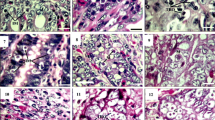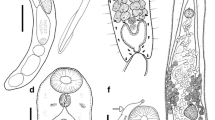Summary
8 buzzards (Buteo buteo) were infected orally with cysts of Frenkelia clethrionomyobuteonis of the bank vole (Clethrionomys glareolus). Their intestines were searched for developmental stages of Frenkelia 21 and 24 h and 2, 3, 4, and 5 days post infection. After 21 and 24 h male and female gamonts could be detected within epithelial cells of the villi of the first half of the small intestine. The microgamonts contained 10–14 microgametes. The macrogamonts which measured on an average 11,1×9,8 μm in Giemsa stained smears developed into very thin-walled oocysts measuring in fresh preparations on an average 15,8×11,7 μm on day 3 after infection. The oocysts were located between the lamina propria and the epithelial lining of the distal third of the villi. They began to sporulate on day 5 and the first sporocysts were excreted 7 and 8 days post infection. Schizonts and schizont-like stages could not be observed in the developmental cycle in Buteo buteo.
Zusammenfassung
8 Mäusebussarde (Buteo buteo) wurden oral mit Zysten von Frenkelia clethrionomyobuteonis aus Rötelmäusen (Clethrionomys glareolus) infiziert. Ihr Darmtrakt wurde nach 21 und 24 Std sowie nach 2, 3, 4 und 5 Tagen auf Entwicklungsstadien von Frenkelien untersucht. Nach 21 und 24 Std waren in Epithelzellen der Zotten der vorderen Hälfte des Dünndarms weibliche und männliche Gamonten nachweisbar. Die Mikrogamonten enthielten 10–14 Mikrogameten. Die im nach Giemsa gefärbten Ausstrich durchschnittlich 11,1×9,8 μm großen Makrogamonten entwickelten sich bis zum 3. Tag p.i. zu sehr dünnwandigen nativ durchschnittlich 15,8–11,7 μm großen Oozysten. Die Oozysten waren zwischen der Lamina propria und der Epithelzellschicht des lumennahen Drittels der Zotten lokalisiert. Ihre Sporulation begann am 5. Tag, die ersten Sporozysten wurden am 7. bzw. 8. Tag p.i. ausgeschieden. Schizonten oder schizontenähnliche Gebilde traten im Entwicklungszyklus im Mäusebussard nicht auf.
Similar content being viewed by others
Literatur
Fayer, R.: Development of Sarcocystis fusiformis in the small intestine of the dog. J. Parasit. 60, 660–665 (1974)
Heydorn, A.O., Rommel, M.: Beiträge zum Lebenszyklus der Sarkosporidien. IV. Entwicklungsstadien von S. fusiformis in der Dünndarmschleimhaut der Katze. Berl. Münch. tierärztl. Wschr. 85, 333–336 (1972)
Kepka, O., Rezaeian, M.: Chemotaxonomische Untersuchungen an Sarcocystidae (Sporozoa, Apicomplexa). 7. Tag. Dtsch. Ges. Parasit., Berchtesgaden 1976, Zusammenfassungen der Referate, 46.
Kepka, O., Scholtyseck, E.: Weitere Untersuchungen der Feinstruktur von Frenkelia sp. (= M-Organismus, Sporozoa). Protistologica 6, 249–266 (1970)
Munday, B.L., Barker, I.K., Richard, M.D.: The developmental cycle of a species of Sarcocystis occurring in dogs and sheep, with observations on pathogenicity in the intermediate host. Z. Parasitenk. 46, 111–123 (1975)
Rommel, M., Krampitz, H.E.: Beiträge zum Lebenszyklus der Frenkelien. I. Die Identität von Isospora buteonis aus dem Mäusebussard mit einer Frenkelienart (F. clethrionomyobuteonis spec. n.) aus der Rötelmaus. Berl. Münch. tierärztl. Wschr. 88, 338–340 (1975)
Ruiz, A., Frenkel, J.K.: Recognition of cyclic transmission of Sarcocystis muris by cats. J. infect. Dis. 133, 409–418 (1976)
Tadros, W., Laarman, J.J.: A study of serological cross-reaction amongst the four members of the “Toxoplasmea” by the indirect immunofluorescence (I.F.A.) technique. 2nd Europ. Multicoll. Parasit., Trogir 1975, Summaries 9–10
Author information
Authors and Affiliations
Rights and permissions
About this article
Cite this article
Rommel, M., Krampitz, H.E. & Geisel, O. Beiträge zum Lebenszyklus der Frenkelien. Z. F. Parasitenkunde 51, 139–146 (1977). https://doi.org/10.1007/BF00500953
Received:
Issue Date:
DOI: https://doi.org/10.1007/BF00500953




